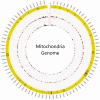Heteroplasmy and Copy Number Variations of Mitochondria in 88 Hepatocellular Carcinoma Individuals
- PMID: 29187876
- PMCID: PMC5706003
- DOI: 10.7150/jca.21218
Heteroplasmy and Copy Number Variations of Mitochondria in 88 Hepatocellular Carcinoma Individuals
Abstract
Hepatocellular carcinoma (HCC) is the third leading cause of cancer mortality worldwide. In this study, we had analysed the copy number variations and heteroplasmic mutations of mitochondria (MT) in 88 HCC individuals. The average copy number of MT genome in normal samples was significantly greater than that in tumor samples. Overall, the number of heteroplasmic mutations in 88 tumor and their matched normal samples were 241 and 173, respectively. There was higher positive ratio of heteroplasmic mutations in tumor samples (86%) than normal samples (73%). Worthwhile mention, ND1 gene harbored greater mutation frequency and more nonsynonymous mutations in tumor samples. Interestingly, 202 tumor-specific heteroplasmic mutations were detected. Moreover, ND1, ND3, ND4, ND5 and ND6 genes had higher ratio of nonsynonymous versus synonymous mutations in tumor-specific heteroplasmic mutations. It might suggest that the disorder of NADH dehydrogenase (complex I) resulted by heteroplasmic mutations may have close relation with tumorigenesis of hepatocellular carcinoma. This study provided theoretical basis for further understanding mechanism of tumorigenesis from the perspective of mitochondrial heteroplasmic mutations.
Keywords: Copy Number; Hepatocellular carcinoma.; Heteroplasmy; Mitochondrial Genome.
Conflict of interest statement
Competing Interests: The authors have declared that no competing interest exists.
Figures



Similar articles
-
Mitochondrial heteroplasmic shifts reveal a positive selection of breast cancer.J Transl Med. 2023 Oct 5;21(1):696. doi: 10.1186/s12967-023-04534-4. J Transl Med. 2023. PMID: 37798736 Free PMC article.
-
Mitochondrial DNA depletion, mitochondrial mutations and high TFAM expression in hepatocellular carcinoma.Oncotarget. 2017 Sep 16;8(48):84373-84383. doi: 10.18632/oncotarget.21033. eCollection 2017 Oct 13. Oncotarget. 2017. PMID: 29137431 Free PMC article.
-
Somatic mutations of mitochondrial genome in hepatocellular carcinoma.Mitochondrion. 2010 Mar;10(2):174-82. doi: 10.1016/j.mito.2009.12.147. Epub 2009 Dec 16. Mitochondrion. 2010. PMID: 20006738
-
Evidence of Neutral Evolution of Mitochondrial DNA in Human Hepatocellular Carcinoma.Genome Biol Evol. 2019 Oct 1;11(10):2909-2916. doi: 10.1093/gbe/evz214. Genome Biol Evol. 2019. PMID: 31599941 Free PMC article.
-
Recent Advances in Detecting Mitochondrial DNA Heteroplasmic Variations.Molecules. 2018 Feb 3;23(2):323. doi: 10.3390/molecules23020323. Molecules. 2018. PMID: 29401641 Free PMC article. Review.
Cited by
-
Mitochondrial Complex I Molecular Alterations in Sapajus apella as a Human Gastric Carcinogenesis Model After MNU Exposure.J Med Primatol. 2025 Apr;54(2):e70017. doi: 10.1111/jmp.70017. J Med Primatol. 2025. PMID: 40166901 Free PMC article.
-
Genome-wide methylation analyses identifies Non-coding RNA genes dysregulated in breast tumours that metastasise to the brain.Sci Rep. 2022 Jan 20;12(1):1102. doi: 10.1038/s41598-022-05050-z. Sci Rep. 2022. PMID: 35058523 Free PMC article.
-
Mitochondrial Inheritance in Phytopathogenic Fungi-Everything Is Known, or Is It?Int J Mol Sci. 2020 May 29;21(11):3883. doi: 10.3390/ijms21113883. Int J Mol Sci. 2020. PMID: 32485941 Free PMC article. Review.
-
Roles of MT-ND1 in Cancer.Curr Med Sci. 2023 Oct;43(5):869-878. doi: 10.1007/s11596-023-2771-0. Epub 2023 Aug 29. Curr Med Sci. 2023. PMID: 37642864
-
The Length and Distribution of Plasma Cell-Free DNA Fragments in Stroke Patients.Biomed Res Int. 2020 Jan 30;2020:9054196. doi: 10.1155/2020/9054196. eCollection 2020. Biomed Res Int. 2020. PMID: 32090114 Free PMC article.
References
-
- Caldwell S, Park SH. The epidemiology of hepatocellular cancer: from the perspectives of public health problem to tumor biology. J Gastroenterol. 2009;44(Suppl19):96–101. - PubMed
-
- Lu FM, Zhuang H. Management of hepatitis B in China. Chinese medical journal. 2009;122:3–4. - PubMed
-
- Wei YH. Mitochondrial DNA mutations and oxidative damage in aging and diseases: an emerging paradigm of gerontology and medicine. Proceedings of the National Science Council, Republic of China Part B, Life sciences. 1998;22:55–67. - PubMed
LinkOut - more resources
Full Text Sources
Other Literature Sources

